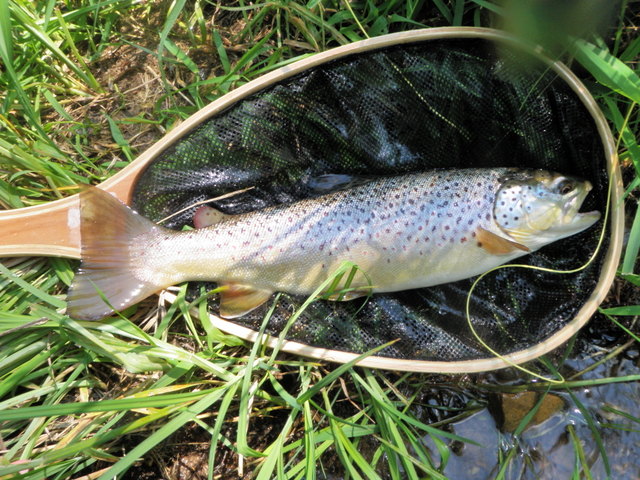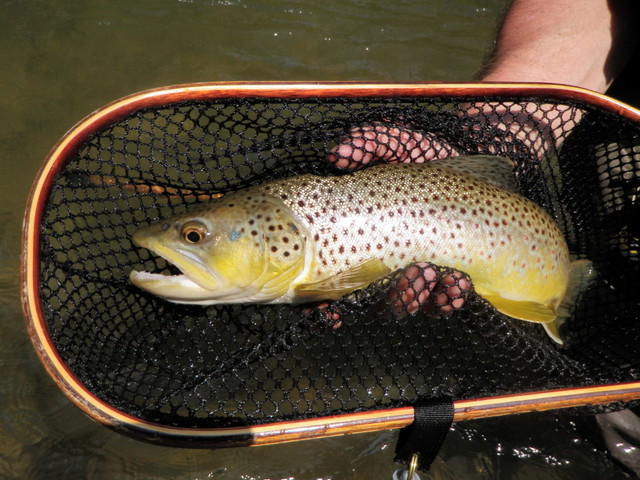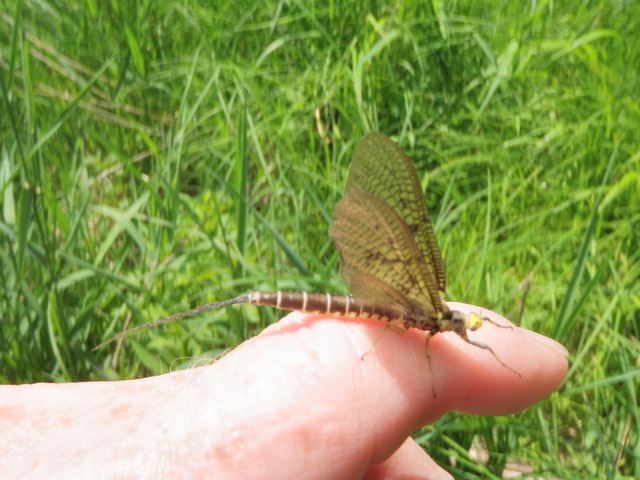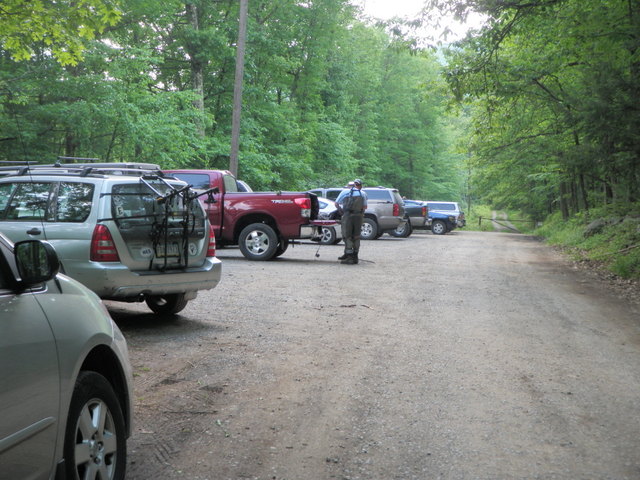Time: 9:30AM – 8:30PM
Location: Section downstream from the no kill area.
Penns Creek 06/03/2016 Photo Album
I was unaccustomed to sleeping in luxurious accommodations such as the cottage we enjoyed on Wednesday and Thursday night in Aaronsburg, Pa. Normally I am camping and need to take down a wet tent before proceeding to my stream of choice. But here I was at the Schafer Cottages with a bed, a toilet and a shower. What more could a fisherman ask for? In addition to the plush lodging, we had several options for breakfast on Friday morning, so we drove a short distance to downtown Millheim and entered the Inglebean Coffee House. This stop proved to be a nice discovery, and the menu featured breakfast pastries and sandwiches in addition to quality tea and coffee. Jeff sampled a sandwich, while I devoured a yogurt parfait, black tea and a delicious scone. Scones and tea were made for each other.
After breakfast we traveled south and east to the section of Penns Creek below the no kill area. Earlier forecasts predicted heavy rain most of Friday, so we were uncertain we could complete our planned full day of fishing. Jeff checked his radar app in the morning, while we had a strong signal, and he concluded that a large mass of moisture would slide by us to the south. I listened and hoped that his meteorological skills matched his fishing ability. The air did feel humid and quite a few large clouds rolled across the sky causing cool temperatures. Before we settled into our parking space near Penns Creek, Jeff took me on a brief tour to a section of river quite a bit downstream. This location received numerous feeder creeks, and consequently the clarity of the water was somewhat compromised as a result of the heavy rain on Thursday, although Jeff was confident that it was easily within the range where fish would respond to flies and natural insects.
We assembled our rods in the stretch below the No Kill and walked a short distance to the stream, and I was surprised to notice that the water clarity was much improved compared to the downstream segment, although there was slightly more brown color than Thursday. Jeff wanted to introduce me to some water farther upstream than the section that we fished on Wednesday evening, so we walked up a lane a good distance and then cut down to the creek. We met a long slow pool behind a yellow cabin. I asked Jeff if there was faster water, and he directed me upstream. I followed his wave and found an area with numerous deep runs and slots and exposed boulders.

Jeff in the Mist on Friday Morning
On the previous two days I did not experience much luck with dry flies or the dry/dropper approach in the morning, so I decided to experiment with a nymphing rig. I deployed a strike indicator and tied a weighted slumpbuster to my line. As an added enticement, I knotted a section of leader through the eye of the slumpbuster and then tied a prince nymph to the end. I began at the top of the bumpy water and began casting three quarters upstream and then allowed the two flies to tumble through deep slots on a dead drift. When the flies reached the end of their natural drift, I introduced short rapid strips, as I hoped to activate the slumpbuster into a bait fish imitation.

First Brown Came from This Area on a Leadwing Coachman
After a half hour of fishing in this manner with two bumps but no landed fish, I decided to substitute the leadwing coachman that Jeff loaned me for the prince nymph. It was longer and probably yielded a better match to the locally present isonychia nymphs. This change proved successful, and at the head of the long deep pool behind the cabin, I felt a bump and then a grab, and then I was attached to a fish. I battled the thrashing weight on my line for a bit, and then lifted it over the edge of my net and celebrated the landing of a fourteen inch brown trout that snatched the leadwing coachman on the strip. I finally cracked the code and landed a fish in the morning on Penns Creek.

Gorgeous Markings on This Brown Trout
I released the brown trout and continued working downstream using the same technique. After another half hour the indicator paused along a deep current seam, and I once again set the hook. I was pleased to feel a throbbing weight and fought another fourteen inch brown trout for a few minutes, until I once again guided it into my net. This brown was slightly longer and heavier than my first catch, and it also displayed the leadwing coachman in its lip.
My enthusiasm for stripping a slumpbuster and leadwing coachman accelerated, but unfortunately the euphoria was short lived, as I continued fishing some attractive water downstream with no reward for my focused efforts. Meanwhile the sky grew darker, so I decided to seek Jeff. Earlier I saw him as he walked above me toward what he described as butter hole, so I climbed to the path on the bank and began walking upstream. I passed behind the last set of cabins in the area and continued until I was forced to clamber up some rocks and through rhododendrons to a narrow path. It was about this time when rain began to descend, so I paused to pull on my raincoat. After another five minutes on the path, I did not spot Jeff, so I concluded that he somehow passed downstream of the area I was fishing.
I retreated and stayed on the upper path until it connected with a lane comprised of two tire tracks. Fortunately I followed this, and it led me to Jeff’s minivan, and he was there when I arrived. We debated our next move, and Jeff suggested that we sample the water near where we were parked for an hour, and then we planned to return to the No Kill. The rain slowed down, and we proceeded to follow Jeff’s plan. As we walked along the road in the morning, Jeff pointed to a fifty yard stretch of the creek that he called “the canyon”. According to Jeff one of the residents of the surrounding cabins caught fish after fish in this fast narrow area using nymphs. This was all I needed to hear to attract me to the canyon, so I crossed at the top and walked down the opposite bank until I was nearly at the bottom of the faster water.
This segment of the creek was more open than the morning stretch, so I decided to return to the dry/dropper technique, but after fifteen minutes or so of fruitless casting and wading, I observed a few sporadic rises. The fish showed no interest in my fat Albert or trailing nymphs, so I decided to switch to a single dry approach. Explosive sporadic rises indicated isonychia to me, so I knotted an iso comparadun to my line. I was unable to provoke additional rises from the area where I spotted fish earlier, but I did manage to hook and land a twelve inch brown that was along a short run near the bank.
I moved up the stream a bit, and once again I was excited to see a couple rises, but they were toward the middle, and on the opposite side of a strong center current. I attempted to counter the drag caused by the intervening run, but I was unsuccessful. It was at this time that the sun reappeared, and I was quite warm in my raincoat, so I removed it and stuffed it in my backpack. Unfortunately the visor on the hood of the raincoat was my only tool to block the suddenly bright sunlight, so I had to hold my left hand above my eyebrows while I cast and drifted my comparadun. This was not an ideal situation, so I hiked back to my initial crossing point and found Jeff, who flipped me a spare key. I returned to the minivan and promptly snugged my hat on my head. I quickly chomped a sandwich and minimal lunch and grabbed a water for Jeff and returned to him with the keys and the bottle of water.
Since I was now on the side of the creek next to the road, I walked down to a place directly across from where I saw the risers. I waded in a bit, and on the fifth drift over the spot of the closest riser, a strong gulp made the comparadun disappear! This brown trout put up a strong fight, and when I examined it nestled in my net, I could see that it was a fine fifteen inch fish. Based on the appearance of the rise, I would never have guessed the trout was that large.

This Beauty Came from The Canyon
Despite Jeff’s suggestion that we give the area an hour, we continued fishing the canyon until four o’clock. I adopted the approach that yielded the fourteen inch brown on the iso comparadun for the remainder of the afternoon, and added one more brown trout in the 14-15 inch range. I scanned the water for the occasional rise, and once a fish revealed its position, I moved within casting range. Four times during this period I hooked a substantial fish on the isonychia comparadun, but the last two slipped free with strong downstream runs and relentless head shaking. After a gang of beer drinking tubers passed through the area, Jeff joined me, and he had some success with his leadwing coachman.

Jeff Works the Leadwing Coachman
By 4PM the action subsided, so Jeff and I returned to the car to discuss plans for the evening. Apparently his weather forecast was accurate, as the skies cleared, and the lack of clouds suggested a pleasant evening. We decided to move downstream a short distance to the scene of the blue winged olive spinner fall on Wednesday. Jeff bought some new spinners at the Feathered Hook, so we were prepared for another feeding frenzy.
The plan partially succeeded as we fished from 5PM until 8:30 in the area around the long island behind the cabins. I landed an eleven inch brown trout on a hare nation nymph from the small eddy at the downstream tip of the island, before I crossed to the far bank along the left channel. Unlike Wednesday evening the creek was now swarming with weekend fly fishermen, and a tall young man occupied the shallow riffle that provided me with abundant surface action two nights earlier. I was forced to station myself in a nice moderate riffle and short pool two thirds of the way down the island. The section was nice water, but it did not appeal to me as much as the upper area.
Sometime between 7:30 and 8:30 I spotted three or four rises along some rose bushes on the island at the downstream portion of the pool. I seined the water and confirmed that blue winged olive spinners were once again floating along with their outstretched flat wings. I quickly knotted one of my old trusty poly wing spinners to my line, and I waded across the tail of the pool so I was below the risers. I executed a huge number of casts to the area, but I was unsuccessful. Because the fish were within a foot or two of the bank, I was careful not to overshoot and hook a rose bush. This caution, however, prevented me from making my usual pile cast with a lot of slack to avoid instant drag. Consequently the flies were probably dragging over the spot of the rises more than half the time. The low light and low riding spinner also made it difficult for me to follow the fly to determine if was dragging or not.
I finally surrendered to the fish and waded back to the bank and then walked upstream looking for more rises. I invited Jeff to cast to the rises I abandoned, since he possesses much better casting skills. He obliged, and while he moved into position at the low end of the pool, I spotted two rises in the center downstream from a large branch that arced over the stream. I began making downstream drifts to the two time riser, and on the fifth attempt saw a slurp in the vicinity of my fly. I quickly set the hook and brought chubby eleven inch brown trout to my net.

Finally Cooperative
The spinner fall on Friday night only lasted for thirty minutes maximum. The short duration and the large population of fishermen constrained my spinner fall fishing experience. By 8:30 the surface of the river was dead, twilight was upon us, and we faced a two hour and fifteen minute drive to Whitehall, Pa. We decided to end our day and carefully waded back to the bank behind the cabins and walked along the road to the car. My 2016 Pennsylvania fishing adventure reached its final chapter.
Friday proved to be my best day from a numbers perspective, as I landed seven fine Pennsylvania brown trout. The afternoon time period when I spotted sporadic rises and followed up with targeted presentations of my isonychia comparadun were the highlight of the day, although landing two nice fish on the leadwing coachman technique was also fun. I am not certain when I will revisit central Pennsylvania, but after listening to Jeff’s description of trips earlier in the season, I get excited over the prospect of fishing to hendricksons and March browns. These hatches overlap during early May, so perhaps that will be my next Pennsylvania field trip.
Fish Landed: 7
Like this:
Like Loading...










